Ophthalmic Hydrogel Contact Lens Material Containing Magnesium Oxide Nanoparticles and 3-(Trifluoromethyl)styrene for Biomedical Application
Abstract
1. Introduction
2. Materials and Methods
2.1. Reagents and Materials
2.2. Polymerization
2.3. Analysis
3. Results and Discussion
3.1. Thermal Properties
3.2. Physical Properties
3.2.1. Refractive Index and Water Content
3.2.2. Optical Transmittance
3.2.3. Oxygen Permeability
3.2.4. Tensile Strength
3.2.5. Test for Absorbance and Extractables
3.2.6. Antimicrobial Test
3.3. Surface Property
3.3.1. Wettability
3.3.2. AFM Analyses
4. Conclusions
Author Contributions
Funding
Institutional Review Board Statement
Informed Consent Statement
Data Availability Statement
Conflicts of Interest
References
- Patrick, J.C.; Craig, W.N. History of contact lenses. Contact Lens Spectr. 2022, 37, 48. [Google Scholar]
- Zafar, M.S. Prosthodontic Applications of Polymethyl Methacrylate (PMMA). Polymers 2020, 12, 2299. [Google Scholar] [CrossRef] [PubMed]
- Tran, N.P.D.; Yang, M.C. Synthesis and characterization of silicone contact lenses based on TRIS-DMA-NVP-HEMA hydrogels. Polymers 2019, 11, 944. [Google Scholar] [CrossRef] [PubMed]
- Seidel, J.M.; Malmonge, S.M. Synthesis of polyHEMA hydrogels for using as biomaterials. Bulk and solution radical-initiated polymerization techniques. Mater. Res. 2000, 3, 79–83. [Google Scholar] [CrossRef]
- Chatterjee, S.; Upadhyay, P.; Mishra, M. Advances in chemistry and composition of soft materials for drug releasing contact lenses. RSC Adv. 2020, 10, 36751–36777. [Google Scholar] [CrossRef]
- Elisseeff, J.; Puleo, C.; Yang, F.; Sharma, B. Advances in skeletal tissue engineering with hydrogels. Orthod. Craniofac. Res. 2005, 8, 150–161. [Google Scholar] [CrossRef]
- Lin, C.C.; Andrew, T.M. Hydrogels in controlled release formulations: Network design and mathematical modeling. Adv. Drug Deliv. Rev. 2006, 58, 1379–1408. [Google Scholar] [CrossRef]
- Woodward, G. The Effects of Contact Lens Wear on the Ocular Environment. Optom. Today 1999, 2, 27–34. [Google Scholar]
- Brennan, N.A.; Coles, M.L.C.; Comstock, T.L.; Levy, B. A 1-year prospective clinical trial of balafilcon A(PureVision) silicone-hydrogel contact lenses used on a 30-day continuous wear schedule. Ophthalmology 2002, 109, 1172–1177. [Google Scholar] [CrossRef]
- Wang, J.; Fonn, D.; Simpson, T.L.; Jones, L. Precorneal and preand postlens tear film thickness measured indirectly with optical coherence tomography. Investig. Ophthalmol. Vis. Sci. 2003, 44, 2524–2528. [Google Scholar] [CrossRef]
- Aakre, B.M.; Ystenaes, A.E.; Doughty, M.J.; Austrheim, Ø.; Westerfjell, B.; Lie, M.T. A 6-month follow-up of successful refits from daily disposable soft contact lenses to continuous wear of high-Dk silicone-hydrogel lenses. Ophthalmic Physiol. Opt. 2004, 24, 130–141. [Google Scholar] [CrossRef] [PubMed]
- Lee, K.J.; Mun, M.Y.; Buyn, J.W.; Leem, H.S. Changes in objective and subjective responses in soft contact lens wearers refitted to daily-wear silicone hydrogel contact lenses. J. Korean Ophthalmic Opt. Soc. 2007, 12, 43–54. [Google Scholar]
- Pozuelo, J.; Compañ, V.; González-Méijome, J.M.; Gonzalez, M.R.; Mollá, S. Oxygen and ionic transport in hydrogel and silicone-hydrogel contact lens materials: An experimental and theoretical study. J. Membr. Sci. 2014, 452, 62–72. [Google Scholar] [CrossRef]
- Li, L.; Xin, Z. Surface-hydrophilic and protein-resistant tris(trimethylsiloxy)-3-methacryloxypropylsilane-containing polymer by the introduction of phosphorylcholine groups. Colloids Surf. A 2011, 384, 713–719. [Google Scholar] [CrossRef]
- Kwon, Y.H.; Song, M.H.; Hwang, Y.G.; Chang, S.H.; Hong, W.J. Effect of materials structure and composition on properties of siloxane-containing hydrogels. Curr. Appl. Phys. 2008, 8, 486–489. [Google Scholar] [CrossRef]
- Hu, Y.; Yang, D.; Ma, D.; Huang, S. Extremely sensitive mechanochromic photonic crystals with broad tuning range of photonic bandgap and fast responsive speed for high-resolution multicolor display applications. Chem. Eng. J. 2022, 429, 132342. [Google Scholar] [CrossRef]
- Hu, Y.; Wei, B.; Yang, D.; Ma, D.; Huang, S. Chameleon-Inspired Brilliant and Sensitive Mechano-Chromic Photonic Skins for Self-Reporting the Strains of Earthworms. ACS Appl. Mater. Interfaces 2022, 14, 11672–11680. [Google Scholar] [CrossRef]
- Hu, Y.; Zhang, Y.; Chen, T.; Yang, D.; Ma, D.; Huang, S. Highly Efficient Detection of Homologues and Isomers by the Dynamic Swelling Reflection Spectrum. ACS Appl. Mater. Interfaces 2020, 12, 45174–45183. [Google Scholar] [CrossRef]
- Zhang, Y.; Wei, B.; Yang, D.; Ma, D.; Huang, S. Artificial Chameleon Skins Active Mimicking Reversible Off/On Structural Colors of Insect Wings. Adv. Mater. Interfaces 2022, 9, 2201252. [Google Scholar] [CrossRef]
- Moreddu, R.; Vigolo, D.; Yetisen, A.K. Contact Lens Technology: From Fundamentals to Applications. Adv. Healthc. Mater. 2019, 8, 1900368. [Google Scholar] [CrossRef]
- Park, S.H.; Lee, Y.I.; Jeon, I.C. Vision Correction Glasses Use Status in Korea. Korean J. Vis. Sci. 2019, 21, 509–523. [Google Scholar] [CrossRef]
- Kim, D.H. Color soft contact lens and corneal thickness. J. Korean Clin. Health Sci. 2019, 7, 1205–1214. [Google Scholar]
- Lee, S.; Hyung, S.M.; Koh, S.W.; Park, M.; Kim, S.R. The Effect of Circle Contact Lens on the Stability of Tear Film. J. Korean Ophthalmic Opt. Soc. 2015, 20, 125–131. [Google Scholar] [CrossRef][Green Version]
- Chen, M.J.; Chang, K.J.; Hsu, C.C.; Lin, P.Y.; Liu, C.J.L. Precaution and prevention of coronavirus disease 2019 infection in the eye. J. Chin. Med. Assoc. 2020, 83, 648–650. [Google Scholar] [CrossRef] [PubMed]
- Bakar, N.A.; Rosbi, S. Effect of coronavirus disease(COVID19) to tourism industry. Int. J. Adv. Eng. Res. Sci. 2020, 7, 189–193. [Google Scholar] [CrossRef]
- Sun, C.; Wang, Y.; Liu, G.; Liu, Z. Role of the Eye in transmitting human coronavirus: What we know and what we do not know. Front. Public Health 2020, 8, 155. [Google Scholar] [CrossRef] [PubMed]
- Qing, H.; Li, Z.; Yang, Z.; Shi, M.; Huang, Z.; Song, J.; Song, Z. The possibility of COVID-19 transmission from eye to nose. Acta Ophthalmol. 2020, 98, e388. [Google Scholar] [CrossRef]
- Kim, J.H.; Song, J.S.; Hyon, J.Y.; Chung, S.K.; Kim, T.J. A survey of contact lensrelated complications in Korea: The Korean contact lens study society. J. Korean Ophthalmol. Soc. 2014, 55, 20–31. [Google Scholar] [CrossRef]
- Choi, T.H.; Kim, H.M.; Cha, H.W.; Kim, J.C.; Kim, M.S.; Lee, H.B. Research on the current status of contact lenses in Korea. J. Korean Ophthalmol. Soc. 2004, 45, 1833–1841. [Google Scholar]
- Boost, M.; Poon, K.C.; Cho, P. Contamination risk of reusing daily disposable contact lenses. Optom. Vis. Sci. 2011, 88, 1409–1413. [Google Scholar] [CrossRef]
- Kim, T.H.; Sung, A.Y. Physical characterization and contact lens application of polymer produced with propylene glycol additive. J. Korean Chem. Soc. 2010, 54, 105–109. [Google Scholar] [CrossRef][Green Version]
- Suchecki, J.K.; Donshik, P.; Ehlers, W.H. Contact lens complications. Ophthalmol. Clin. N. Am. 2003, 16, 471–484. [Google Scholar] [CrossRef]
- Green, M.; Apel, A.; Stapleton, F. Risk factors and causative organisms in microbial keratitis. Cornea 2008, 27, 22–27. [Google Scholar] [CrossRef] [PubMed]
- Papas, E. On the relationship between soft contact lens oxygen transmissibility and induced limbal hyperaemia. Exp. Eye Res. 1998, 67, 125–131. [Google Scholar] [CrossRef]
- Papas, E.B. The significance of oxygen during contact lens wear. Cont. Lens. Anterior Eye 2014, 37, 394–404. [Google Scholar] [CrossRef] [PubMed]
- Mishima, S. Clinical investigations on the corneal endothelium. Ophthalmology 1982, 89, 525–530. [Google Scholar] [CrossRef]
- Iskeleli, G.; Karakoc, Y.; Ozkok, A.; Arici, C.; Ozcan, O.; Lpcioglu, O. Comparison of the effects of first and second generation silicone hydrogel contact lens wear on tear film osmolarity. Int. J. Ophthalmol. 2013, 6, 666–670. [Google Scholar] [PubMed]
- Sheng, H.; Bullimore, M.A. Factors affecting corneal endothelial morphology. Cornea 2007, 26, 520–525. [Google Scholar] [CrossRef]
- Lee, M.J.; Sung, A.Y. Polymerization and Preparation of Functional Ophthalmic Material Containing Carbon Nanoparticles. Mater. Res. Soc. Korea 2018, 28, 452–458. [Google Scholar] [CrossRef]
- Jayashree, B.S. A Descriptive Study of the Regulations of Leachable and Extractables of US, Europe, and Canada. Int. J. Pharm. Pharmacol. 2018, 2, 1–15. [Google Scholar]
- ISO 10993-18; Biological Evaluation of Medical Devices—Part 18: Chemical Characterization of Materials. ISO: Geneve, Switzerland, 2020.
- Lee, M.J.; Sung, A.Y. Polymerization and Preparation of High Functional Ophthalmic Lens Material Containing 2-Fluoro Styrene with Si and Ag Nanoparticles. Sci. Adv. Mater. 2020, 12, 427–434. [Google Scholar] [CrossRef]
- Geoghegan, M.; Krausch, G. Wetting at polymer surfaces and interfaces. Prog. Polym. Sci. 2003, 28, 261–302. [Google Scholar] [CrossRef]
- Gu, H.; Wang, C.; Gong, S.; Mei, Y.; Li, H.; Ma, W. Investigation on contact angle measurement methods and wettability transition of porous surfaces. Surf. Coat. Technol. 2016, 292, 72–77. [Google Scholar] [CrossRef]
- Wenzel, R.N. Resistance of solid surfaces to wetting by water. Ind. Eng. Chem. 1936, 28, 988–994. [Google Scholar] [CrossRef]
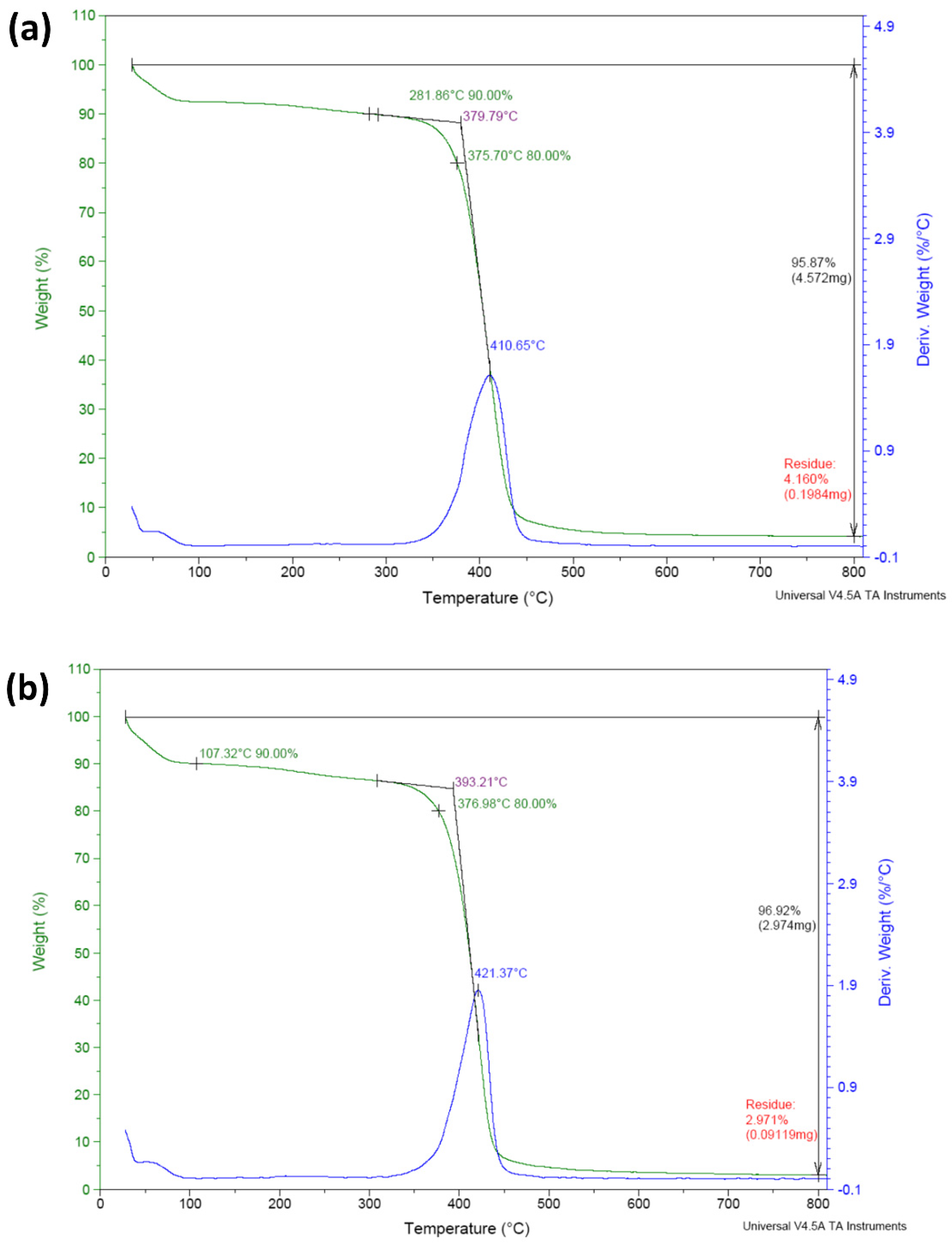

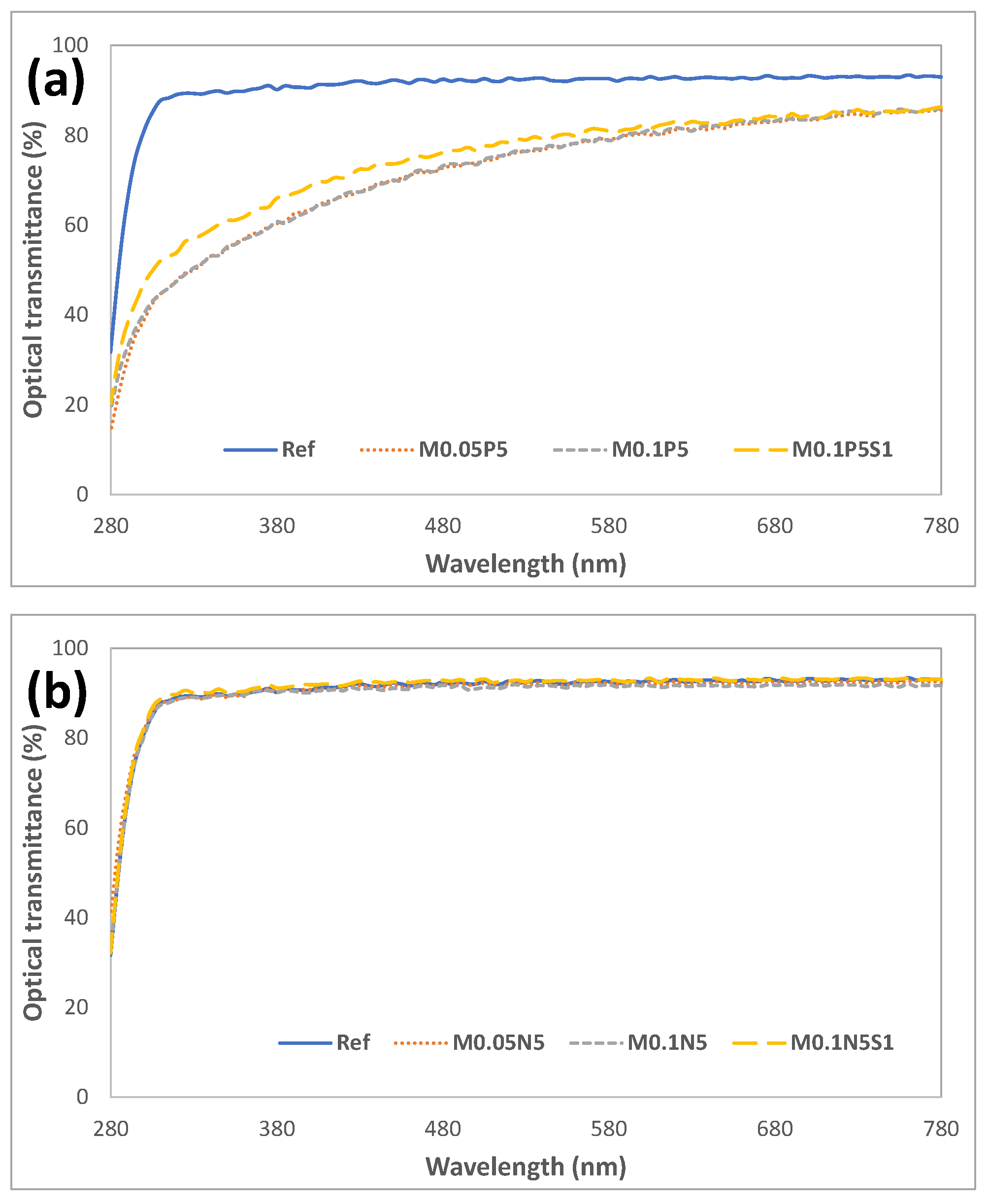
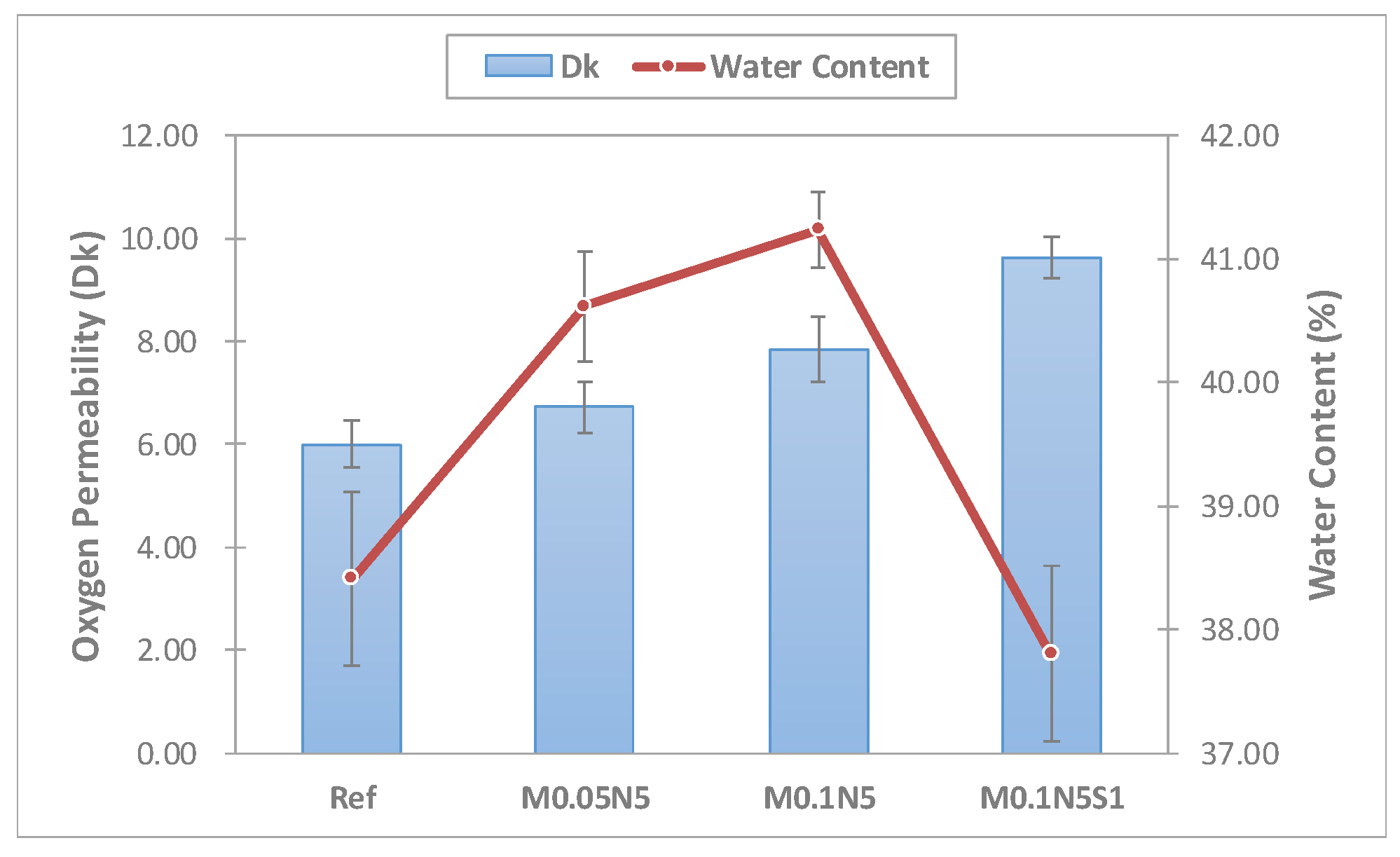



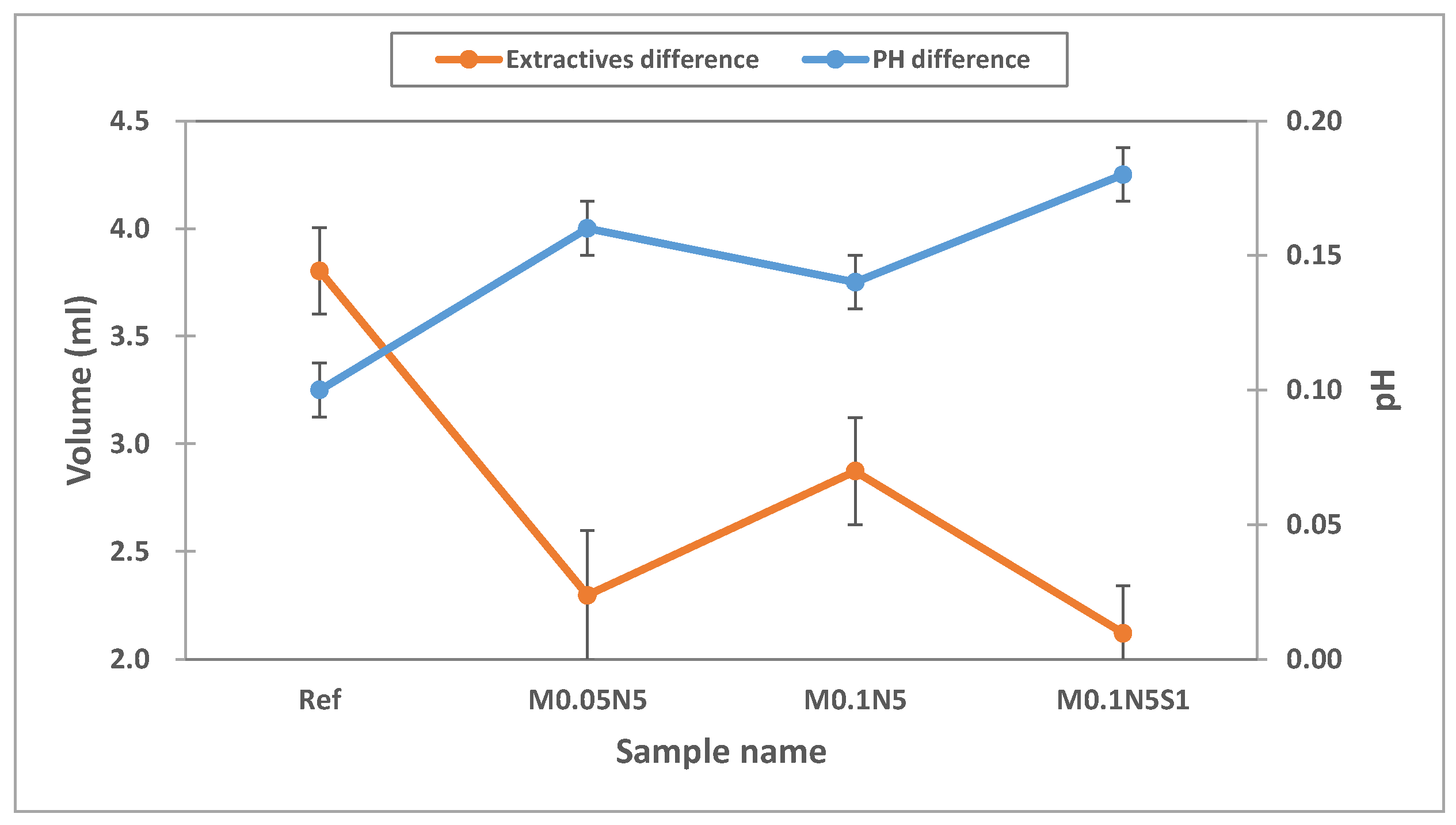
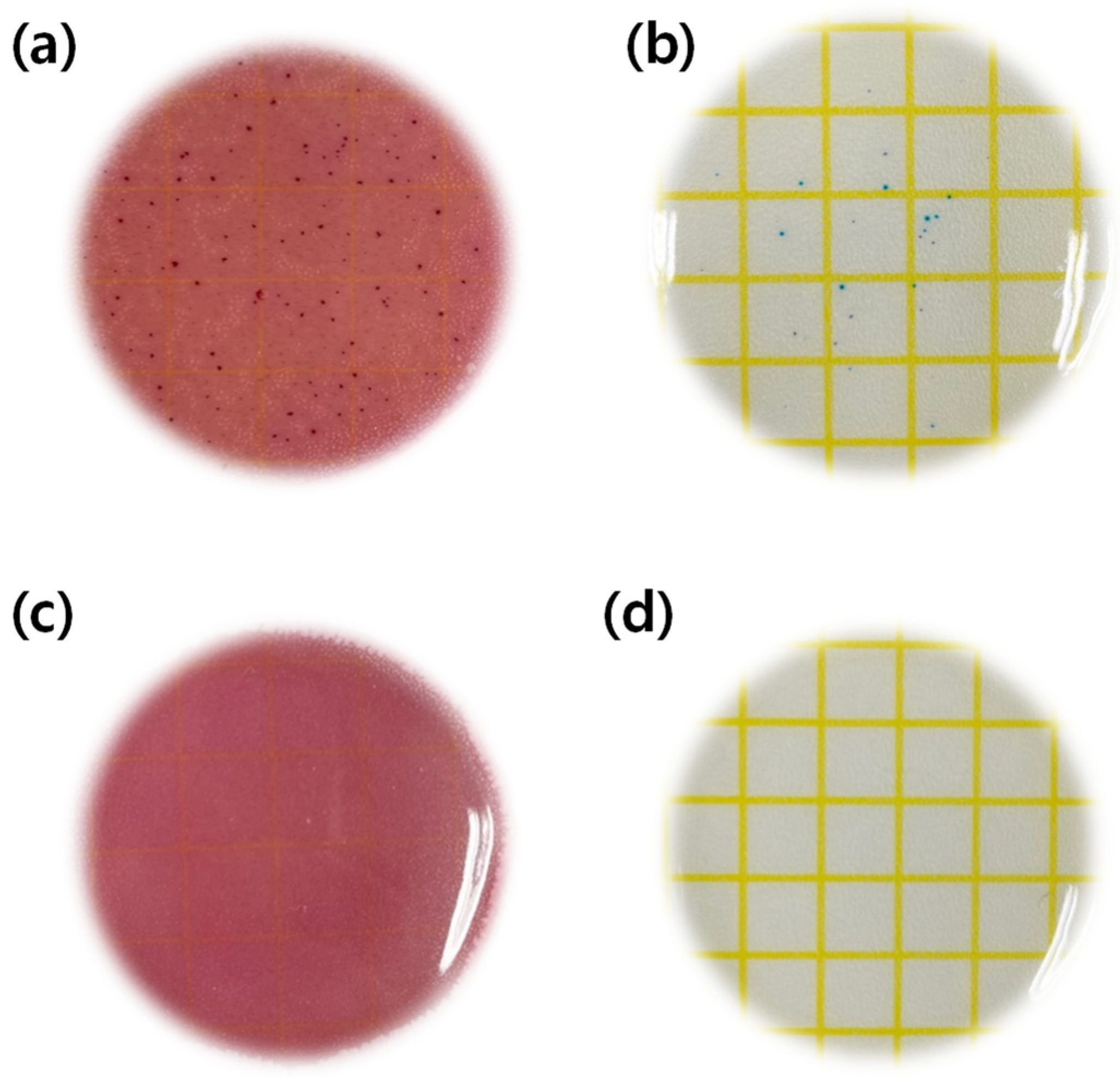


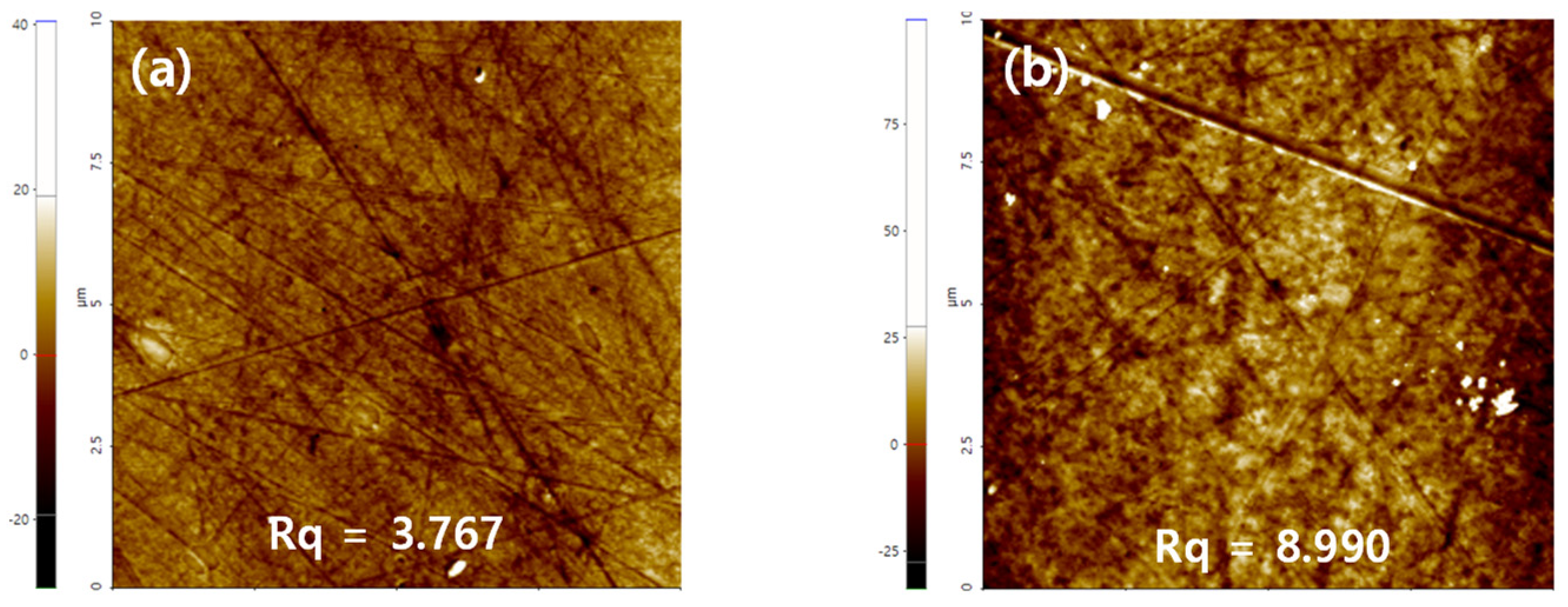
| Sample Name | HEMA | PVP | NVP | MO * | 3-TFMSt | EGDMA | AIBN | Total |
|---|---|---|---|---|---|---|---|---|
| Ref | 99.3 | - | - | - | - | 0.50 | 0.20 | 100 |
| M0.05P5 | 94.53 | 4.73 | - | 0.05 | - | 0.50 | 0.20 | 100 |
| M0.05N5 | 94.53 | - | 4.73 | 0.05 | - | 0.50 | 0.20 | 100 |
| M0.1P5 | 94.48 | 4.72 | - | 0.10 | - | 0.50 | 0.20 | 100 |
| M0.1N5 | 94.48 | - | 4.72 | 0.10 | - | 0.50 | 0.20 | 100 |
| M0.1P5S1 | 93.55 | 4.68 | - | 0.10 | 0.98 | 0.50 | 0.20 | 100 |
| M0.1N5S1 | 93.55 | - | 4.68 | 0.10 | 0.98 | 0.50 | 0.20 | 100 |
Publisher’s Note: MDPI stays neutral with regard to jurisdictional claims in published maps and institutional affiliations. |
© 2022 by the authors. Licensee MDPI, Basel, Switzerland. This article is an open access article distributed under the terms and conditions of the Creative Commons Attribution (CC BY) license (https://creativecommons.org/licenses/by/4.0/).
Share and Cite
Lee, M.-J.; Park, S.-Y.; Sung, A.-Y. Ophthalmic Hydrogel Contact Lens Material Containing Magnesium Oxide Nanoparticles and 3-(Trifluoromethyl)styrene for Biomedical Application. Micromachines 2022, 13, 1897. https://doi.org/10.3390/mi13111897
Lee M-J, Park S-Y, Sung A-Y. Ophthalmic Hydrogel Contact Lens Material Containing Magnesium Oxide Nanoparticles and 3-(Trifluoromethyl)styrene for Biomedical Application. Micromachines. 2022; 13(11):1897. https://doi.org/10.3390/mi13111897
Chicago/Turabian StyleLee, Min-Jae, Seon-Young Park, and A-Young Sung. 2022. "Ophthalmic Hydrogel Contact Lens Material Containing Magnesium Oxide Nanoparticles and 3-(Trifluoromethyl)styrene for Biomedical Application" Micromachines 13, no. 11: 1897. https://doi.org/10.3390/mi13111897
APA StyleLee, M.-J., Park, S.-Y., & Sung, A.-Y. (2022). Ophthalmic Hydrogel Contact Lens Material Containing Magnesium Oxide Nanoparticles and 3-(Trifluoromethyl)styrene for Biomedical Application. Micromachines, 13(11), 1897. https://doi.org/10.3390/mi13111897






